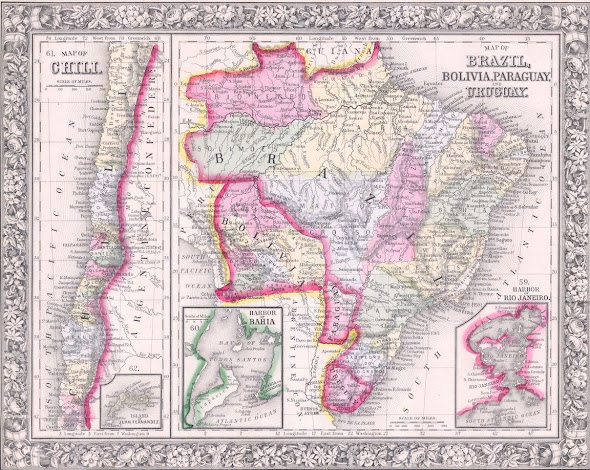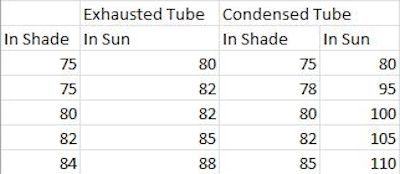The Golden Spike--Building the Trans-Continental Railroad
If you had asked the rail barons pushing to build a transcontinental railroad, "Will you make a profit selling tickets? Will you make a profit hauling farm crops and manufactured goods?" they would answer, "Certainly."
If they were being utterly candid, though, they'd add, "Of course, that's not where the really big and quick money is."A transcontinental railroad was proposed in the early 1840s. Before the war with Mexico, its route would have been from Chicago and St Louis to the coast of Oregon. Southern senators and representatives in Congress opposed this, fearing it would simply bring more anti-slavery immigrants into the northern plains, creating more free soil states and breaking the grip minority pro slavery states had on Congress.
Adding Texas and the land gained by the Mexican War which ended in 1848, changed the debate. The following year, 1849, with discovery of gold in California, there was sudden demand for travel to the new found gold fields.
Congress remained deadlocked. Southern members did not want to build a road leading to Sacramento as it would be a "northern" line. To widen the debate, Congress commissioned Gadsden to negotiate the purchase of enough land south of the high Rockies from Mexico to make a southern line to San Diego feasible. Fearing the South would have an alternate port from which to export cotton if it seceded, Northern congressmen blocked including Baja California and the northern coast of the Gulf of California as part of the Gadsden purchase (and now you know why Arizona has no beach front property.)
With the purchase of what became the southern part of Arizona and a bit of New
Mexico, the debate became should it follow a southern route from New Orleans to
San Diego, or a northern route from Chicago or St Louis to Sacramento?
Railroad barons in both the East and the West realized it would engorge their already obscenely large fortunes whichever route was built. They were major backers of the Republican party from the beginning. Rail barons did not care that the Republicans were vehemently anti Mormon or that the Republicans were anti-slavery. Rail barons supported the Republicans because Republicans favored unrestricted, open immigration. Most immigrants were European farmers and wanted land.
Influence in Washington assured rail barons could buy Federal right-of -way land for very little. Vast acreage to either side of the planned route was required, sometimes, justifiably so. There had to be areas in which water and wood stations could be built, side tracks built, space for the workers to live in as the tracks progressed, and room to shift the route slightly if required. Still, building the railroad did not require the amounts of land the railroad men acquired.
As the railroads progressed, they planned
to sell the excess right of way on either side to immigrant settlers at high
prices, (after all, it is so convenient to the train line) reaping a
quick huge profit. Long term profits would be made once the immigrant
farmers were in place, by charging exorbitant freight rates to ship
corn and other farm goods.
And the Federal government would pay the railroads qualifying to build the route $16,000 per mile of track laid and up to $48,000 per mile for track laid through the Rocky Mountains.
With the outbreak of the American Civil War, Southern congressmen left Washington and Northern Republicans settled on a Northern route in July 1862. The route covered some land held by various Native American tribes through peace treaties made with the United States. The rail barons saw nothing wrong in violating the treaties. That and the arrival of tens of thousands of settlers provoked wars with the plains tribes that would culminate at Wounded Knee in 1890.
Building the railroads, the actual hard work of surveying, grading, tunneling, and laying the track, demanded a great deal of labor. Irishmen and other European immigrants constituted a majority of workers working on the East to West portion. Labor was much tougher to find in California. Most recent immigrants had come to California to make a fortune mining gold or selling supplies to miners. Few were interested in working for low regular wages.
And the Federal government would pay the railroads qualifying to build the route $16,000 per mile of track laid and up to $48,000 per mile for track laid through the Rocky Mountains.
With the outbreak of the American Civil War, Southern congressmen left Washington and Northern Republicans settled on a Northern route in July 1862. The route covered some land held by various Native American tribes through peace treaties made with the United States. The rail barons saw nothing wrong in violating the treaties. That and the arrival of tens of thousands of settlers provoked wars with the plains tribes that would culminate at Wounded Knee in 1890.
Building the railroads, the actual hard work of surveying, grading, tunneling, and laying the track, demanded a great deal of labor. Irishmen and other European immigrants constituted a majority of workers working on the East to West portion. Labor was much tougher to find in California. Most recent immigrants had come to California to make a fortune mining gold or selling supplies to miners. Few were interested in working for low regular wages.
At
first, builders of the West to East portion were reluctant to use Chinese labor
that had come in with the 1849 Gold Rush. “Celestials,” as the Chinese were
originally called, were too small and physically weak to do the hard work
needed. Once tried, the rail barons
realized the Chinese worked harder for less money and began actively recruiting
an Asian labor force which grew to 20,000 by the time the project was finished.
Where they worked together, the Irish despised the Chinese, seeing the Chinese as competition for jobs. Irish workers played several dangerous and deadly “jokes” on the Chinese workers. The Chinese workers did not run away or cower. The Chinese developed their own deadly “jokes,” which soon brought about an uneasy truce.
Safety and innovation were largely ignored as taking away too much money in terms of operating costs.
Completed in 1869, the railroads were determined to squeeze every nickel out of the poor they could before cashing out. The railroads hiked ticket rates. Trains consisting of little more than cattle cars became converted to a terra firma version of the ocean crossing in steerage most immigrants experienced. The immigrant trains from New Orleans or Chicago might take ten days to three weeks to reach Sacramento, often parked on a siding for several days in blistering heat or deep cold. Hope you packed more than just one lunch!
Not everybody riding the trains West to East or East to West travelled in squalor. George Pullman hit upon the idea of building luxurious railroad cars the companies could use for their own executives as well as sell tickets offering a bed, toilets, cabin service and so on for a high ticket price as well. Pullman was not doing anything the railroad companies could not have built themselves. It had just never occurred to them because it would have required spending money. Once Pullman’s cars came on the scene railroad companies started buying them rapidly. The cost of the car was a legitimate expense from the companies’ point of view and insured the wealthy board members would ride in luxury, as would their guests who might be persuaded to invest in the railroad as well.
The middle class did not travel in cattle cars or Pullmans. As rail routes pushed westward into less inhabited country, small stations grew up along the lines. Passengers could have a meal in the train station while the locomotives took on water and coal or wood.
Hotels and restaurants of widely varying quality popped up along the tracks. Guidebooks recommending which places were good and which not became best-selling travel books. This led to a uniquely American merchandising innovation--predictable standards and quality in a series of restaurant stops. One might refer to it in modern times as a “MacDonald-ism.”
Where they worked together, the Irish despised the Chinese, seeing the Chinese as competition for jobs. Irish workers played several dangerous and deadly “jokes” on the Chinese workers. The Chinese workers did not run away or cower. The Chinese developed their own deadly “jokes,” which soon brought about an uneasy truce.
Safety and innovation were largely ignored as taking away too much money in terms of operating costs.
Completed in 1869, the railroads were determined to squeeze every nickel out of the poor they could before cashing out. The railroads hiked ticket rates. Trains consisting of little more than cattle cars became converted to a terra firma version of the ocean crossing in steerage most immigrants experienced. The immigrant trains from New Orleans or Chicago might take ten days to three weeks to reach Sacramento, often parked on a siding for several days in blistering heat or deep cold. Hope you packed more than just one lunch!
Not everybody riding the trains West to East or East to West travelled in squalor. George Pullman hit upon the idea of building luxurious railroad cars the companies could use for their own executives as well as sell tickets offering a bed, toilets, cabin service and so on for a high ticket price as well. Pullman was not doing anything the railroad companies could not have built themselves. It had just never occurred to them because it would have required spending money. Once Pullman’s cars came on the scene railroad companies started buying them rapidly. The cost of the car was a legitimate expense from the companies’ point of view and insured the wealthy board members would ride in luxury, as would their guests who might be persuaded to invest in the railroad as well.
The middle class did not travel in cattle cars or Pullmans. As rail routes pushed westward into less inhabited country, small stations grew up along the lines. Passengers could have a meal in the train station while the locomotives took on water and coal or wood.
Hotels and restaurants of widely varying quality popped up along the tracks. Guidebooks recommending which places were good and which not became best-selling travel books. This led to a uniquely American merchandising innovation--predictable standards and quality in a series of restaurant stops. One might refer to it in modern times as a “MacDonald-ism.”
Fred Harvey, an English immigrant, had the idea of
good food and good service as a consistent offering at all the trains’ stops. Harvey built seventeen elegant restaurants along the rail lines in the Southwest. At one point, he was so outraged with the poor service at one of his establishments, he fired all the waiters. Unable to hire enough male replacements, he hired young women, an innovation at the time. The move to female servers was so popular he began advertising in Eastern newspapers for single women between 18 and 30. Soon, "Harvey Girls" were well known and considered far more moral and desirable than saloon dancers. So many of them married within their first year of employment, Harvey revised their contracts that they forfeited half their wages if they married before completing a year of employment.








Comments
Post a Comment